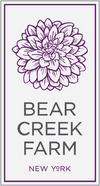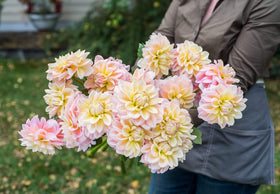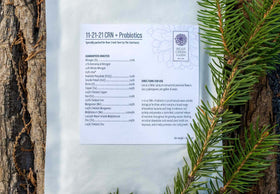Today I am going to remind you about the seminal role of seeds. While the importance of seeds may seem obvious, it is my experience that the floral varieties that come from seeds are not always fully appreciated. These beauties hide in plain sight, humble if not fully hiding. Their vibe is more hide-and seek. (While on the subject, might I remind, that seeds are inexpensive – offering a generous return on investment in terms of both time and expense.) As an added bonus, many require very little tending.
I understand why people forget about seeds. I am a flower farmer, and I am therefore intensely aware of the waves of certain floral “seasons.” By this, I mean those brief blink-and-its-over waves of extravagant blooms. First there are poppies which emerge from hibernation before people are paying much attention. They suggest a quickening. Then, there are tulips, and the snow is melting. By June the peonies come sleepily back, awakening before their phosphorescent glow signals fireflies and long last lit evenings. Finally, the end of summer is an explosion of dahlias in every color – so diverse one is reminded of how novel things are always possible. The well of creativity in songs, stories, and – yes - horticulture is deep. All of these stems and blossoms fill me up. Of course, they do.
But allow me to return to seeds. What I have listed above are bookends. The early flowers of spring awaken our imaginings. The apparent “stars” of summer flowers are evidence of pure magic, sending us back through time in some visceral/sensory manner, indefinable. Dahlias are an outsized goodbye kiss to high summer as they grow just as the first hints of fall hang in the air.
And so, the long and short of it is that on the face of it, within the long season of summer, there are these micro-seasons of growth – with some seeming gaps. What blooms in the hottest time in the hottest climes? What gentle petal could possibly stand tall against heat and not wither?
The answer? Lots of them. Many from inexpensive seeds. These seeming gaps in midsummer are deceptive. July is full of flowers; although it is admittedly harder to remember with specificity which ones they are. Driving by a roadside farm stand, a bouquet of flowers wrapped in a brown sleeve offers any number of shades of textured gorgeousness.

These bouquets may contain things along with foraged leaves. Cosmos are pretty low-key glorious - nodding in all their periwinkle, white or pink modesty. Sunflowers, so often written off as too yellow, too big (and the stuff of preschool projects abandoned on a windowsill, forgotten, and not watered, that never came up) – are far more complex in their colors than most people understand. Red sunflowers exist with petals of graduated hues from dramatic scarlets to softer rouge. Zinnias grow in multiple shades from salmon to green – to name but a few. Zinnias are a wonderful way to plant with children – they are easy to grow and return more than we have any right to expect. One can use seeds to align as a partner with nature in the creation of pollinator gardens.
Most of these high summer flowers are most likely to have been propagated from seed. Many of them are obliging in how easy they are to grow, how very forgiving. Many seeds do extremely well in challenging conditions – including a lack of rain, and high heat. These flowers are less fussy than some of their botanical cousins. These high summer flowers grown from seed make it oh so easy. Isn't that what we want our summers to be?
Now that you've finished reading this article, you should check out our tulip planting primer, dahlia growing guide, and cutting guide for dahlias. And if you're shopping for dahlia tubers, make sure to check out our giant dahlia tubers (10"+ blooms), micro dahlia tubers (under 2" blooms), dark pink dahlia tubers, dark red dahlia tubers, and bicolor dahlia tubers.





Beautifully expressed! Thank you